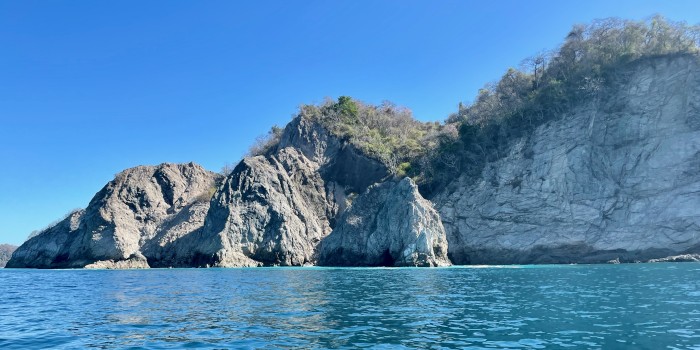Costa Rica by Sea
11 April 2022
• Marina Papagayo
by Melissa Kenshalo • Sunny with Papagayos!

February 9 - April 11, 2022
The rugged shoreline of Costa Rica lures those who love the water. Dancing on the Edge traveled from Panama to Northern Costa Rica. We traveled along the jungle like shores of the Golfito, often called Banana Bay, to the arid shores of Bahia Culebra, renamed Bahia Papagayo for the Four Seasons Resort. We expected the Pacific Ocean, the winds and the waves to "be different" from the Caribbean Sea. Well, there are some differences. Pacific means peaceful and our coastal cruise was peaceful. Where were the famous Papagayo winds? Where were the square waves? Our trip was a motor with some adverse current. Ocean swells rolled to shore creating many surf breaks. So, what was different? We cruised without seeing other cruising boats. Rocky shores with deep waters were untenable for anchoring or for shore landing. Dan fished--fish on, slow the boat, land the fish, release the fish. One day Dan caught and released 6 skipjack tuna and a baby mahi in about 2 hours. Fish number eight, a beautiful Spanish mackerel, tasted delicious.
The Golfito Dulce, mangrove lined and sparsely populated, is magnificent. Stars, scarlet macaws, spoonbills, howler monkeys, and not so friendly reptiles make this a beautiful spot. The small village of Golfito is easily accessible on foot. The Spanish speaking residents are friendly. Tourists are few. The deep-water port keeps the area well supplied. We watched yachts load onto transit vessels. Maria and Steve Siguaw supervised as the IP Aspen floated aboard for passage to the USVIs. M/V MoDoc, a 1944 WWII auxiliary tug, Captained by Peter Bethune and guard dog Appa, departed for the Panama-Colombian border. Earthrace is working with government and environmental groups to prevent animal poaching near gold mines. We loved sharing the "backwater" town with family, Becky and John Wheeler, at Banana Bay Marina.
We visited Isla Tortugas with interesting rock pillars and formations and the sheltered anchorage at Curu in the Golfo de Nicoya. Our dinghy ride took us over the clearest marine blue water we have seen in the Pacific--sunlight shimmered on the water and radiated about 30ft down to a grass covered bottom. The white sand beach on Isla Tolinga, visited by pangas full of tourists, contrasted with the dark volcanic sand at Curu. The Curu Reserve Park is part of a private finca with a tiny museum, walking trails and a small restaurant. We walked along a trail in search of new world monkeys. Dr. Dan, curious about the communication patterns of the white-faced Capuchins, showed an open mouthed "threat" gesture. He really got their attention and provided a chuckle for all. We shared an excellent TICO lunch with Alaskans, Donna and Grant, on the IP Vagabondo Dos. The beach is flat and the tides are big. We beached the dinghy at low tide and needed help to drag it about 150 ft. to the water. Whew--dinghy wheels are on the shopping list!
As the land changed from green to brown, anchorages became scarce. Quepos, a walkable town, fills with tourists who visit Manuel Antonio National Park. English is the predominant language. Dancing on the Edge was one of 4 masts in the 200 slip Marina Pez Vela. I have never seen so many 80-100 ft. sport fishers in one place. The marina sponsors sport fishing tournaments, an excellent service yard at US prices. The complex has shops, restaurants and bars. Dan shopped extensively in the fishing store. Crew prepared ballyhoo before the Sailfish Slam, a catch and release tournament. We expected boats to race out of the marina in the morning. Not! We expected flags and cheers on the winning boat in the evening. Not! Portofino, Aransas, Texas, caught 24 of the 106 fish!
We entered Bahia Culebra, unofficially renamed Golfo de Papagayo, as the Papagayo winds picked up. These winds blow between November and April. When winter cold fronts reach the Gulf of Mexico and Caribbean, the winds in high pressure system flow toward the Pacific following the path of the trade winds. There are 3 points for the winds to escape--the Chivela Pass in Mexico (known as the Tehuantepecs), Lake Nicaragua in southern Nicaragua, and the Galliard Cut in Panama (known as the Northers). The combination of large-scale meteorological interactions and mountainous land features creates winds at much higher intensity than the trades. They are blustery 30-40 knots that can last for weeks as waves build. If one must navigate during the Papagayos, check the winds gusts and hug the shoreline!
Marina Papagayo is posh--excellent floating docks, water, power, good wifi, a pool, small chandlery, and casual restaurant/bar. A market for provisions--not. We take the shuttle to the town of Cocos for provisions. Cocos is a touristy beach town with lots of visitors. The anchorage along Playa Cocos is full of local pangas. Since there is no dinghy dock, one must pull the dinghy ashore through the waves. It looks most unpleasant. The cruisers and semi-permanent residents are friendly. We have attended regular dock pot lucks with other cruisers. Don and Nina Preuss on S/V Enjoy hail from Annapolis, MD--another example of small world. We have enjoyed walks and fresh caught ahi from Chief, our sport fishing neighbor. We have enjoyed the marina, the people and the facilities while the Papagayos howl!



Comments